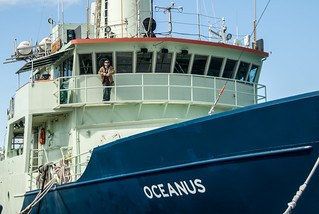September 14, 2018
By Sean Nealon

Students and teachers will join OSU scientists on the R/V Oceanus this month to gain at-sea research experience. (Photo by Pat Kight)
Oregon high school and community college students and teachers will join Oregon State University scientists on the research vessel Oceanus this month to gain at-sea research experience as part of a project to enhance STEM (science, technology, engineering and math) skills.
The cruise, scheduled from Sept. 23 to 26, will depart from Newport, travel south along the Oregon coast to Stonewall and Heceta Banks, before veering northward to the Astoria Canyon, then into the Columbia River to Portland before returning to Newport. The research vessel will dock for two days in Portland, where there will be a series of activities, including tours for Portland area K-12 students.

Students on a 2016 cruise help retrieve the “Sonde,” an instrument used to measure the conductivity, temperature and pressure of seawater. (Photo by Tracy Crews)
The students and teachers participating in the cruise are from high schools in Bandon, Lincoln City and Warrenton, as well as Southwestern Oregon Community College and Oregon Coast Community College.
“This project will provide a transformational educational experience for high school and community college students and their teachers,” said Tracy Crews, marine education manager for Oregon Sea Grant. “By immersing students and teachers in at-sea research, we hope to increase the STEM-related skills of all participants and encourage students to seek out STEM careers.”
During the cruise, participants will conduct marine mammal and seabird surveys and correlate the presence and absence with oceanographic data. They will also conduct plankton tows where marine mammals are located to determine prey availability. Photo-identification of whales will be conducted to describe individual movement patterns, and the team will fly drones over whales to document behavior and assess body condition.
The project is a collaborative effort from Oregon Sea Grant, Oregon State’s College of Earth, Ocean and Atmospheric Sciences and the Oregon Coast STEM Hub, which serves educators, students and communities along the Oregon coast and is located at the Hatfield Marine Science Center in Newport. The research vessel Oceanus is operated by Oregon State University and owned by the National Science Foundation.
Leigh Torres, an assistant professor at Oregon State and a member of the university’s Marine Mammal Institute, and Kim Bernard, an assistant professor at Oregon State who leads the Zooplankton Ecology Lab, will be the chief scientists on the excursion.








 NEWPORT – Michael Courtney and Annie Thorp, longtime volunteers at Oregon State University’s Hatfield Marine Science Center, return to sea this week as support crew for Dr. Clare Reimers, an ocean ecologist and biogeochemist with OSU’s Colleage of Earth, Ocean and Atmospheric Sciences, who is studying the role of seafloor processes in ocean chemical cycles, the influences of low oxygen conditions on ocean biology, geology and chemistry, and new electrochemical tools for ocean observing networks.
NEWPORT – Michael Courtney and Annie Thorp, longtime volunteers at Oregon State University’s Hatfield Marine Science Center, return to sea this week as support crew for Dr. Clare Reimers, an ocean ecologist and biogeochemist with OSU’s Colleage of Earth, Ocean and Atmospheric Sciences, who is studying the role of seafloor processes in ocean chemical cycles, the influences of low oxygen conditions on ocean biology, geology and chemistry, and new electrochemical tools for ocean observing networks.